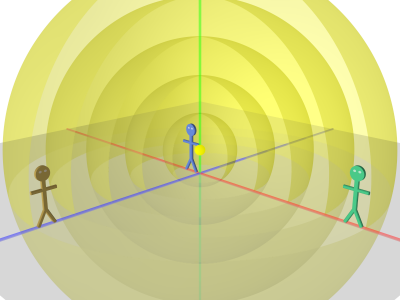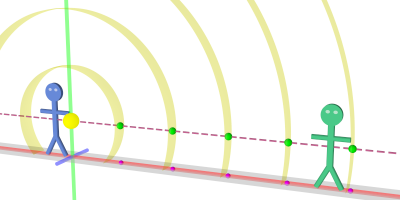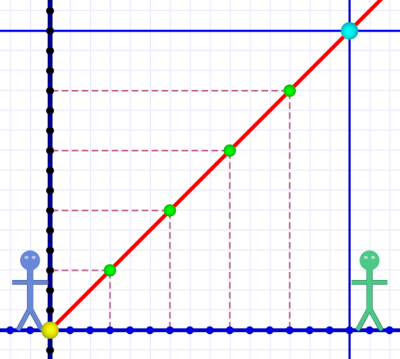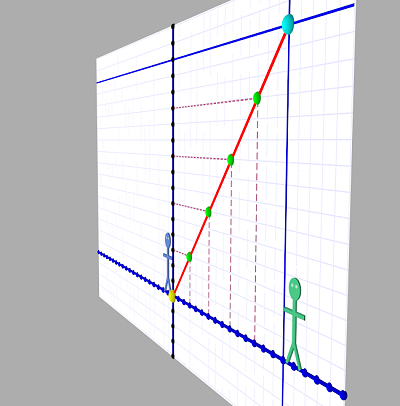SR Appendix-1: Extra Diagrams
A couple of readers have asked about the diagrams in this series of Special Relativity posts. I created them with the freeware 3D ray tracing application, POV-Ray. The diagrams are actually three-dimensional "scenes" designed to be viewed as flat pieces. If some of the "dots" look more like little spheres, that's because they are!
I wrote some introductory posts a while ago (here, here, and here). You can read those if you want more details about the application.
For a little (optional!) Friday fun, I thought I'd share some POV-Ray images that have a bit more "dimension" to them.
This is a set of images I made to illustrate how we reduce three-dimensional space down to a single distance dimension for our time-space diagrams. Given all we've talked about this week, hopefully this will all make perfect sense to you!
 Diagram A. The 3D world with Al (center), Em (right), and Max (left). Al is holding a flashing lamp (the small yellow ball).
Diagram A. The 3D world with Al (center), Em (right), and Max (left). Al is holding a flashing lamp (the small yellow ball).Al stands in the center holding a flashing lamp. Em and Max each stand at a distance from him at 90-degree angles. Each flash of the lamp creates a sphere of light expanding away from the lamp (at light speed).
The floor is glass to show the spheres. A big wedge is cut in the part of the spheres facing us to let us see their structure more easily and to make their position in space more apparent.
 Diagram B. Al and Em in 2D Flatland. Max didn't make the cut!
Diagram B. Al and Em in 2D Flatland. Max didn't make the cut!We slice off the "to and fro" direction in order to reduce the world to two dimensions. (This, unfortunately, excludes Max.) Now the flashes are rings of light expanding away from the lamp (like what you get if you drop a pebble in a pond).
The dashed line indicates the line of space-time events of interest to us. Green dots along that line mark the position of light flashes moving towards Em. The flashing lamp is the point in space we'll call x=0.
A truly 2D world would be less than paper-thin (even paper has a thickness), but here I left some depth to help the visualization.
 Diagram C. Now we're down to a 1D world!
Diagram C. Now we're down to a 1D world!Now we chop off the "up and down" direction to reduce the world to 1D — a single dimension of distance. We're only showing the light moving towards Em. The light rings are now just "pulses" of light. Green "event" dots depict their position.
Al and Em are just icons shown to indicate their relative positions. This is always the case in these diagrams. Their world lines are their true positions. Using actor-observers gives us friendlier names to use than the anonymous "A" and "B" (it is a bit of a shame Ms Noether wasn't a "Beatrice" — "Al and Be" would have been awesome).
A truly 1D world is just a line, but a bit of both excluded dimensions is again included for visualization sake.
 Diagram D. A time-space diagram of the situation.
Diagram D. A time-space diagram of the situation.Here's how we use a time-space diagram to depict the light going from Al to Em. The yellow dot represents the lamp, the cyan dot represents the event of Em detecting a flash.
The vertical line next to Al is the lamp's world line (the position of which we're calling x=0). The lamp isn't moving, so its world line is strictly vertical.
Likewise, the vertical line next to Em represents her motionless position some distance from the lamp. Technically, it represents the position of whatever detects the light flashes — her eyes or a light detector she's holding. Regardless, Em isn't moving, so her world line is also strictly vertical.
The green dots again represent flashes on their way towards Em. The dashed lines show how each of these has a t (time) coordinate and an x (space) coordinate that can be measured.
Remember that a horizontal line indicates a "snapshot" of time, so each green dot represents a flash's location at that moment in time. Alternately, a vertical line indicates a position in space, so each dot also represents when a flash was located at that position.
 Diagram E. The 3D reality of the above diagram!
Diagram E. The 3D reality of the above diagram!Lastly, here's what that time-space diagram looks like if we move the "camera" way to the right (and closer to the diagram).
You can see how the dots are actually spheres and that Al and Em have a little bit of physical depth. In fact, the lines are actually little rods, although that's hard to tell in this image.
If you're interested in seeing more of what POV-Ray can do, you can check these projects of mine:
- The NCC-1701 Enterprise (Kirk's original Star Trek ship).
- The TARDIS (from Doctor Who).
- A theatre I made for two posts about light and color.
- The light & color posts: Part 1 and Part 2
Or you can just browse the posts with the POV-Ray tag.
